Baños de Doña María de Padilla
Baths of Dona Maria de Padilla
Useful Information
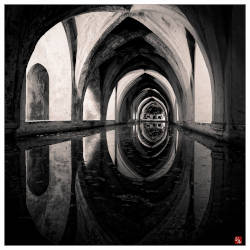
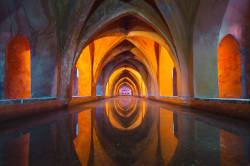
| Location: |
Reales Alcázares de Sevilla.
(37.38382161179711, -5.990887762277369) |
| Open: |
All year daily 9:30-17:30. [2020] |
| Fee: |
Adults EUR 9.50, Students (17-25) EUR 2, Children (0-16) free, Sevillians free, Disabled free, Seniors (65+) EUR 2. [2020] |
| Classification: |
 Cistern Cistern
|
| Light: |
 Electric Light Electric Light
|
| Dimension: | |
| Guided tours: | self guided, guided tours available |
| Photography: | allowed |
| Accessibility: | no |
| Bibliography: | |
| Address: |
Baños de Doña María de Padilla, Tel: +34-646-156-814.
E-mail: |
| As far as we know this information was accurate when it was published (see years in brackets), but may have changed since then. Please check rates and details directly with the companies in question if you need more recent info. |
|
History
| 913 | erected as a moorish fort. |
| 1248 | fell to the Christians and became the home of Fernando III. |
| 12th century | cistern constructed. |
| 13th century | Gothic rib vaults added. |
| 1755 | repair works after the Lisbon earthquake converted the cistern into a basement. |
| 1987 | inscribed on the UNESCO World Heritage List. |
Description
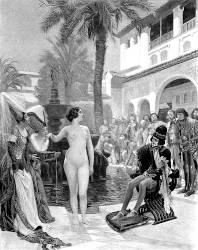
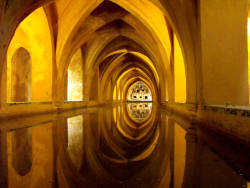
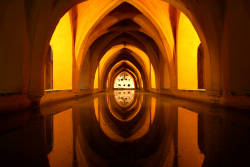
The Reales Alcázares de Sevilla (Royal Alcázar of Seville) is a royal palace in the city of Seville in Spain. It was built for the Christian King Peter of Castile on the site of an Abbadid Muslim alcazar which was destroyed after the Christian conquest of Seville. Alcazar or القصر المُورِق (al-Qasr al-Muriq) means lush palace. The name Alcázar is obviously the adaption of the muslim term. The palace is a preeminent example of Mudéjar architecture featuring Gothic, Renaissance and Romanesque design elements from previous stages of construction. The upper levels are still occupied by the royal family when they are in Seville. If they are there, it is closed to the public, if they are not there you can visit their living rooms. The palace was used as a location for the 1962 movie Lawrence of Arabia and for the fifth season of Game of Thrones.
The Baños de Doña María de Padilla (Baths of Dona Maria de Padilla) are actually no baths at all, the name is a sort of saucy joke. It was named after María Díaz de Padilla (*1334 – ✝JUL-1361 Seville), the mistress of King Pedro I of Castile, also named Pedro the Cruel. According to legend she went naked into the cistern to take her baths. Quite unlikely, as the cistern contained the drinking water of the palace, and the water was quite cold. We guess she had other means, to bath in warm water.
The legend is probably a result of her status as a mistress. Pedro and she were obviously in love, but he was forced by his family to marry Blanche of Bourbon. They married in Valladolid, but three days after the wedding he abandoned his wife. He had found out, that she had an affair with his stepbrother Fadrique Alfonso and the agreed dowry could not be paid. Later he imprisoned her in the palace of his mother. So actually he lived with María and had four children with her, while Blanche of Bourbon was his only legitimate wife. María de Padilla died in July 1361, possibly a victim of the plague.
The underground cavernous room, which is located below the Patio del Crucero, is a cistern, in which rain water was collected for use as drinking water. The huge vaulted crypt with three naves is accessed through a barrel vault with the characteristic tiles that leads to the Garden of the Dance. The cistern was built in the 12th or 13th century, Gothic rib vaults were added in the time of King Alfonso X in the second half of the 13th century. The lateral corridors are decorated with Renaissance wall paintings from the 16th century. Obviously not a very good idea, due to the humid conditions they are very difficult to preserve.
After the Lisbon earthquake of 1755 it was necessary to stabilize the palace. The Almohad buildings were covered by Baroque additions. The cistern which was originally open to the garden and contained a fountain became a basement. Its temperature lowered further and the humidity rose, it became known as the coolest place in Seville. As a result the passage outside the pool was used as a warehouse for the Reales Alcázares.
The site is listed on the UNESCO World Heritage List, but the cistern is only one small part of the listing. The entry consists of three buildings which are definitely worth a visit, cathedral, Alcázar and Archivo de Indias. The cathedral has five naves and is the largest Gothic building in Europe. It houses the tomb of Christopher Columbus. Nearby is the Giralda minaret, a masterpiece of Almohad architecture. And the ancient Lonja (important house of commercial activity), which became the Archivo de Indias, contains valuable documents from the archives of the colonies in the Americas.
- See also
 Subterranean World Heritage List
Subterranean World Heritage List Search DuckDuckGo for "Baños de Doña María de Padilla"
Search DuckDuckGo for "Baños de Doña María de Padilla" Google Earth Placemark
Google Earth Placemark Alcázar of Seville - Wikipedia (visited: 01-DEC-2020)
Alcázar of Seville - Wikipedia (visited: 01-DEC-2020) Cathedral, Alcázar and Archivo de Indias in Seville (visited: 01-DEC-2020)
Cathedral, Alcázar and Archivo de Indias in Seville (visited: 01-DEC-2020) Los Baños de doña María de Padilla del Alcázar de Sevilla
Los Baños de doña María de Padilla del Alcázar de Sevilla  (visited: 01-DEC-2020)
(visited: 01-DEC-2020)
 Index
Index Topics
Topics Hierarchical
Hierarchical Countries
Countries Maps
Maps